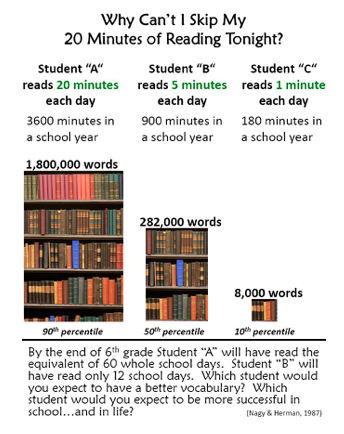Homework and Expectations
A homework folder will come home each Monday and should be returned each Friday. One pocket of the folder will hold graded/reviewed work for you to go over with your child and keep at home. The other pocket has the week’s homework with a sheet explaining the homework.
Other than nightly reading, the activities vary and are designed to be flexible so you can spread out homework throughout the week on a schedule that works best for your family. The recommended amount of time a first grade student should spend on homework is 15 to 20 minutes daily. Each child is different. If your child has a longer attention span and is enjoying homework, then increase the time spent. You know your child best, so use your judgment when deciding how much time your child spends doing homework. If the specific tasks are frustrating your child, please reach out to me so we can brainstorm adjustments.
Here are the general components of our weekly homework:
1 - Daily Reading: As a first grade team, we feel the most important homework activity your child can do is reading daily, so this is where we focus the bulk of our homework time. This could include either your child reading to you or you reading to your child. Ideally, it is a combination of both so that students can practice their own skills and also learn from a fluent reader. Each week, the children will document one book a night on their book log and will be asked to do a short written response to one of their books from the week.
Book Bags- Book Bags: Students will bring home a daily Book Bag Monday through Thursday. As long as they return their book they may check out a different book from our classroom library each day. The comment sheet in your child’s Book Bag serves as a way to comment about your observations about your child’s reading.
In addition, you can use their RazKids account and the library to supplement book choices at home.
2 - Sight Words: “Sight Words” or “High Frequency Words” are a list of words that are used so often in print that together they make up an estimated 75% of all words used in books. Some of the words cannot be decoded using conventional strategies so memorizing them until they are known by sight is beneficial.
You might think that these words are so common that kids would just learn them organically through reading and other everyday print. But many of the words also defy standard phonetic conventions, meaning they are impossible to sound out. They are often also difficult to illustrate, so children can't use illustrations in picture books to make a deeper connection to these words. Can you illustrate "is" or "it?" Me neither.
On the flip side, the wonderful thing about these words being so common is that children learn them easily with repetition because they are usually words that they already have in their everyday vocabulary.
Working hard to learn these words by sight (memorizing) pays off. It allows kids to free up cognitive resources so they can focus on the tougher words that require strong decoding skills. Sight-word knowledge provides a scaffold of understanding and confidence for new readers who need to use all the other tools in their tool box to complete the job at hand: reading with understanding.
**Your child will be tested on their sight word knowledge about every 2 to 3 weeks. They will bring home a Sight Word list. The words they knew automatically will have a check next to them. We will choose 5 words that do not have a check for your child to study -- only focus on 5 at a time! As your child learns these words, we will replace them with new words they need to learn from the list.
3 - Words Their Way- Words Their Way (WTW) is a developmental spelling, phonics, and vocabulary program that is differentiated for each student. Word study teaches students to examine words to discover the regularities, patterns, and conventions of the English language in order to read, write, and spell.
Most weeks, your child will bring home their Word Study “sort” on Monday.
Your child should cut out the words and “sort” them into categories.
**Remind your child to sort the words into categories like the ones in school. Your child should read each word aloud during this activity. Ask your child to explain to you why the words are sorted in a particular way - what does the sort tell about spelling in general? Ask your child to sort them a second time as fast as possible.**
Please see the Words Their Way Handout from Back to School Night for further explanation of this school-wide program.
4- Math Homework- Sometimes the folder will include math worksheets to support math fluency and skills. However, much of our math homework will focus on playing math games that support our Investigations math curriculum. These give the opportunity for the children to practice what they’ve learned in class in an interactive way. Most games can be easily adjusted to provide more or less of a challenge.
Look for materials that might include game boards and cards to come home.
***Please create a place to keep these materials as we will reuse them for different activities throughout the year.***
Homework provides the opportunity to begin to learn responsibility and time management, both skills which are new to your young child!
Please help your child practice these behaviors.
If you or your child ever has any questions about the homework, please contact me!


No comments:
Post a Comment